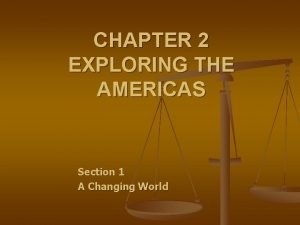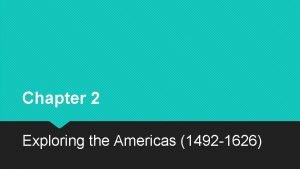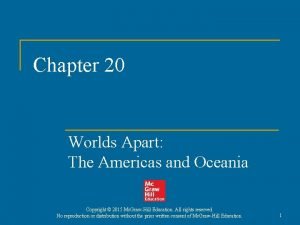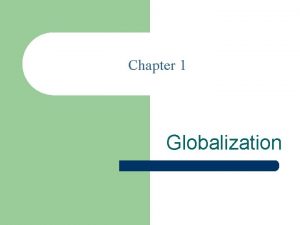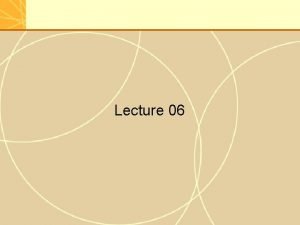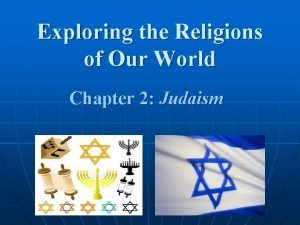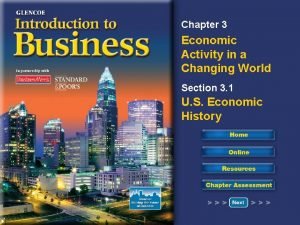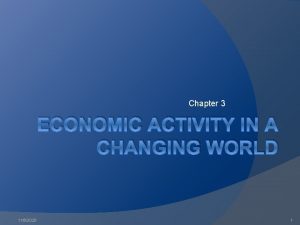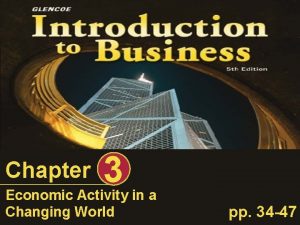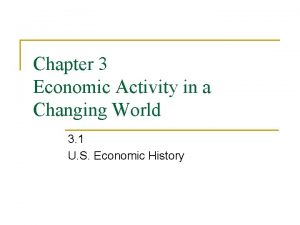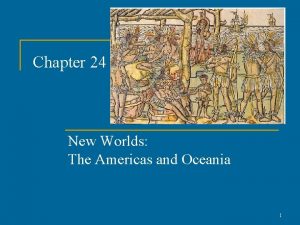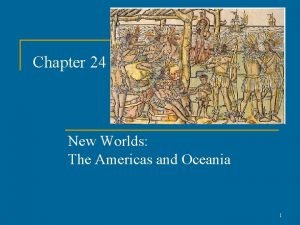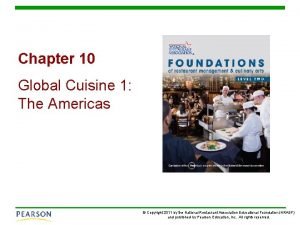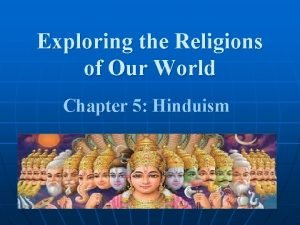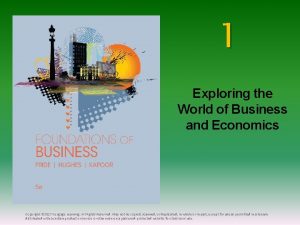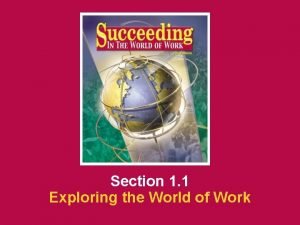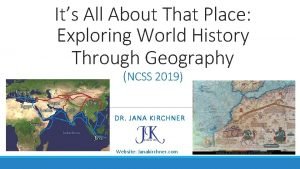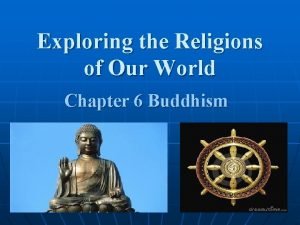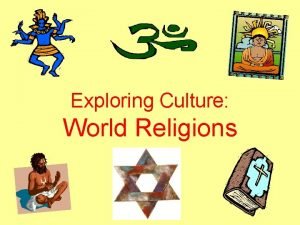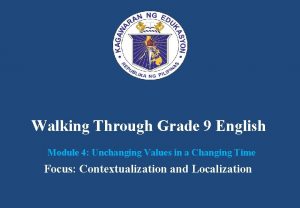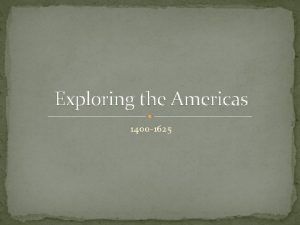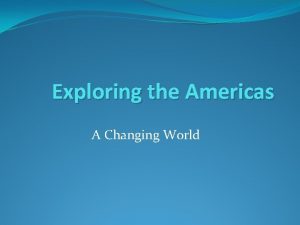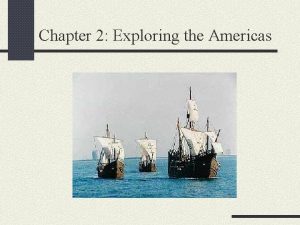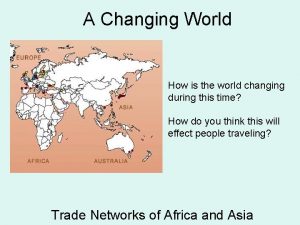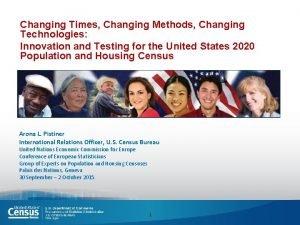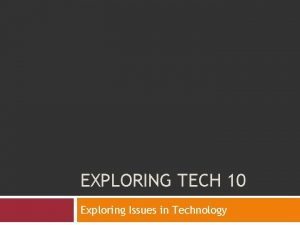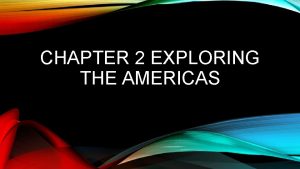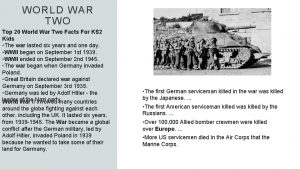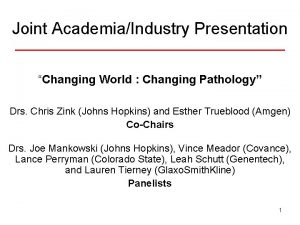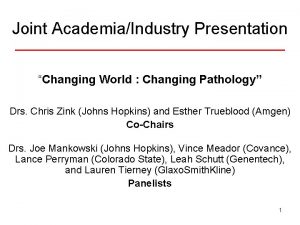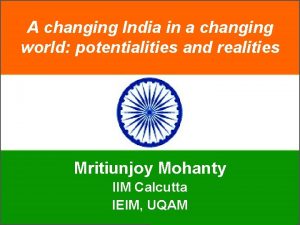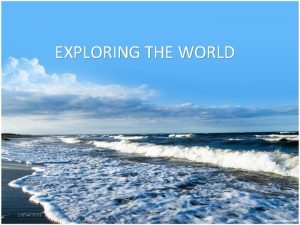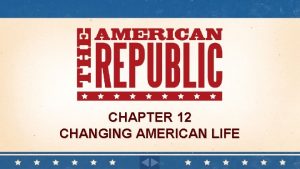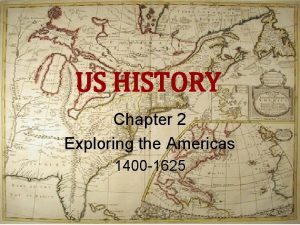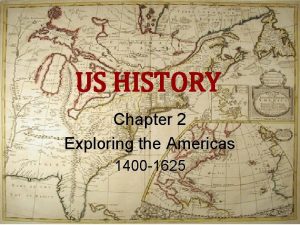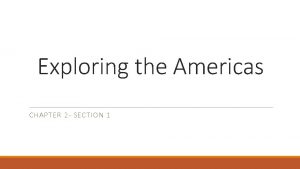Chapter Two Exploring the Americas A Changing World


























- Slides: 26

Chapter Two: Exploring the Americas

A Changing World �Marco Polo’s stories from 1296 inspired people 200 years later �Trade makes countries wealthy, people desired Asian spices, silk, tea �Focus on classical works: Ancient Greek and Roman �Rise in intellectual and artistic creativity: Renaissance (French for “rebirth”) �This encouraged people to pursue new ideas/ goals

Impact of Technology �Technology: use of scientific knowledge for practical purposes �More accurate maps �Astrolabe measured the position of the stars �Better ships �Stern rudder, triangular sail from Arabs �Caravel from Portugal: 3 masted ship, sailed faster, carried more cargo, could float in shallow water

http: //www. ku riositas. com/2 011/04/astrolab e-magnificentcomputerof. html


Seeking New Trade Routes �First maps showed three continents: Europe, Asia, Africa bordered by oceans �They also thought it was only one ocean called the Ocean Sea �Portugal takes the lead- they don’t have a Mediterranean port to go between Asia and Europe � 1420 Prince Henry “The Navigator” of Portugal set up a center for exploration on the southwest tip of Portugal �He brought astronomers, mathematicians, and geographers together �Began to trade down the west coast of Africa: Gold Coast : gold, ivory, slaves


�Bartholomeu Dias � 1487 sent by king of Portugal to explore southernmost tip of Africa �Terrible storm blew him off course and he sailed around it by accident �Dias called it “Cape of Storms, ” but the king renamed it “Cape of Good Hope” �Vasco da Gama � 1497 set off with four ships around Cape of Good Hope and visited east Africa �Met an Arab sailor who helped him navigate to India, and arrived in Calcutta 1498

Crossing the Atlantic �Vikings crossed the Atlantic in the 800 s and 900 s �Made it to Iceland Greenland established settlements �Leif Eriksson landed in what he called “Vinland” in 1000, maybe it was North America? �Didn’t establish a permanent settlement �http: //www. history. com/topics/exploration/leiferiksson

Christopher Columbus � born in Italy 1451 �Became a sailor for Portugal on a merchant ship � 1470 French privateers attacked his ship, he floated to shore on a scrap of wood �Studied math, astronomy, cartography in Lisbon �Thought he could sail around the world in 2 months, 2760 miles (more like 24, 859)…but he couldn’t prove it because he couldn’t afford his own ship and crew

�For most of 1400 s Spain was consumed with getting rid of Muslims and Jews �Last Muslim kingdom in Spain fell in 1492 �King Ferdinand Queen Isabella were already jealous of Portugal’s advances in sailing and trade �Meanwhile Columbus is looking for a sponsor to sail around the world �Spain promised to support him if he �Brought Christianity (Catholicism) to any foreign lands �Bring wealth to Spain if he found a route to Asia (but they promised to give him a cut)

�Set sail on August 3, 1492 �Nina, Pinta, Santa Maria, with a total of 90 men �After a month the crew started to worry and doubt his idea, even threatened mutiny �Spotted land on October 12, the Bahamas, went ashore and claimed it for Spain �he was convinced that he had reached the Indies, and even though he searched for pearls and gold for months in the islands he found nothing �But, he returned to Spain in triumph, leaving 40 men to make a settlement

�September 1493, Columbus returned to the Americas �found the settlement destroyed (to this day, no one knows what happened there) �left his brothers Bartolomeo and Diego behind to rebuild �headed west, with native slaves, to continue his mostly fruitless search for gold and other goods. �Instead of riches he had promised Spain, he sent 500 slaves to Queen Isabella. �The queen was horrified–she believed that any people Columbus “discovered” were Spanish subjects who could not be enslaved–and returned the explorer’s gift.

�Spain and Portugal were now in competition with each other �The Pope had to draw a line from the North Pole to the South Pole to divide the land they had explored �The line of demarcation: Portugal gets lands to the east and Spain gets lands to the west, and the two countries signed an agreement in 1494 to settle the matter

�Amerigo Vespucci � 1499 Made maps of South America coastline �By early 1500 s, Europeans were using his maps and calling the land “America” �Vasco Nunez de Balboa �Governor of a Spanish town in Panama �Had heard stories of “great waters” on the other side of the mountains � 1513 Traveled over land for days, and was the first European to see the Pacific (and claimed it for Spain)

�Ferdinand Magellan � 1519 was hired by the Spanish to travel around/ through South America to Asia �November 1520 found a passage through the tip of South America �His voyage across the Pacific lasted four months �They ran out of food, ate sawdust, rats, and leather �Three years later, Magellan was killed in the Philippines �Only 1 crew member made it to India, and circumnavigated the world

Spain in America �Stories of gold, silver, and wealthy kingdoms sent the Spanish running to the Americas �Conquistadors were explorers who received grants from the government to explore and establish settlements in the Americas �But…they had to give the crown 1/5 of what they found �If they failed they faced losing their own fortune

Hernan Cortes �Landed in Mexico 1519 looking for gold and glory �He had 500 soldiers, horses, and cannons �Marched into Tenochtitlan (Aztec empire) and they welcomed him �But Cortez took advantage of them and took King Montezuma hostage �Spring 1520 Aztecs revolted, Montezuma was killed, Spanish eventually driven out �But Cortes waited for more troops to arrive, and attacked and destroyed the Aztec for good in 1521

Francisco Pizarro � 1532 sailed down Pacific Coast with 180 Spanish soldiers looking for legendary wealthy Incas �Captured the ruler and destroyed the army �In order to get rid of the king, Atahualpa, the Spanish falsely accused him of crimes and executed him

How did Spain succeed? � 1) strange weapons and fearsome animals �Guns and cannons �Horses and dogs � 2) many Native Americans hated their overlords and actually helped the Spanish � 3) diseases that the Spanish unintentionally brought with them wiped out the Natives

Spain in North America �Juan Ponce de Leon landed in Florida 1513 �Looking for gold and the legendary “fountain of youth” �His exploration led to the first Spanish settlement in 1565 at St. Augustine �Alvar Nunez Cabeza de Vaca �Landed in Florida 1528; had some trouble, sailed to Mexico, but in November 5 boats were lost in a storm � 2 survived and landed in Texas, but many men had died �De Vaca and an enslaved African became medicine men � 1533 headed west 1000 miles searching for “seven cities with walls of emerald and streets of gold”

�Hernando de Soto �Inspired by de Vaca to explore Florida and the SW �Wandered around for 3 years looking for gold; would enter a village, take the chief hostage, and demand supplies �Crossed the Mississippi River in 1541, made it as far west as OK, but dies of fever and men buried him in the river �Fransisco Vasquez de Coronado � 1540 traveled through Mexico, AZ, NM, and met the Zuni people �Realized there was no gold, kept going west to CO, then east to KS, but found nothing but “windswept plains” and “shaggy cows” (buffalo)

Spanish Rule �Spanish law established three types of settlements �Pueblos were towns established as centers for trade �Missions were religious communities that usually had a small town, farmland, and a church �Presidios were forts, usually built near a mission

Social Classes �Upper class was Spanish natives: they owned the land ran the local government �Creoles were American born with Spanish parents �Mestizos were Spanish/ Native mixed �Native Americans �Lastly the slaves (Africans) �Spain gave the conquistadors the right to demand taxes or labor from Native Americans, basically enslaving them �Bartolome de Las Casas, a priest, tried to protect them, and some basic laws were passed in 1542, but not always followed

�Plantation system developed �Exported crops and raw materials back to Spain �Tobacco and sugarcane �Native Americans worked the land �Las Casas thought Africans were better suited to the work and encouraged the Spanish to use them instead �Slave trade developed �Spanish brought them from West Africa to North America �Portuguese brought them to Brazil �Las Casas would regret his suggestion

 Chapter 2 exploring the americas study guide
Chapter 2 exploring the americas study guide Chapter 2 exploring the americas
Chapter 2 exploring the americas Chapter 20 the americas and oceania
Chapter 20 the americas and oceania The changing world output and world trade picture
The changing world output and world trade picture The changing world output and world trade picture
The changing world output and world trade picture Exploring the religions of our world chapter 2 pdf
Exploring the religions of our world chapter 2 pdf Exploring the religions of our world chapter 1 pdf
Exploring the religions of our world chapter 1 pdf Chapter 3 economic activity in a changing world
Chapter 3 economic activity in a changing world Chapter 3 economic activity in a changing world
Chapter 3 economic activity in a changing world Chapter 3 economic activity in a changing world
Chapter 3 economic activity in a changing world Chapter 3 economic activity in a changing world
Chapter 3 economic activity in a changing world Chapter 24 new worlds the americas and oceania
Chapter 24 new worlds the americas and oceania New worlds the americas and oceania
New worlds the americas and oceania Chapter 24 the americas and oceania
Chapter 24 the americas and oceania Chapter 10 global cuisine 1 the americas
Chapter 10 global cuisine 1 the americas Aztec farming
Aztec farming Exploring religions chapter 5 large
Exploring religions chapter 5 large Exploring the world of business and economics
Exploring the world of business and economics Exploring the world of work
Exploring the world of work Exploring world history
Exploring world history Exploring religions chapter 6 large
Exploring religions chapter 6 large Religion islam
Religion islam Exploring the religions of our world
Exploring the religions of our world World changing glasgow
World changing glasgow Unchanging values in a changing world example
Unchanging values in a changing world example Systems analysis and design in a changing world
Systems analysis and design in a changing world Systems analysis and design in a changing world
Systems analysis and design in a changing world
